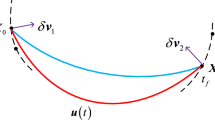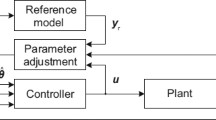Abstract
The set of forces and moments that can be generated by thrusters of a spacecraft is called the “control capability” with respect to the thruster configuration. If the control capability of a thruster configuration is adequate to fulfill a given space mission, we say this configuration is a feasible one with respect to the task. This study proposed a new way to analyze the control capability of the complex thruster configuration. Precise mathematical definitions of feasibility were proposed, based on which a criterion to judge the feasibility of the thruster configuration was presented through calculating the shortest distance to the boundary of the controllable region as a function of the thruster configuration. Finally, control capability analysis for the complex thruster configuration based on its feasibility with respect to the space mission was given followed by a 2-D thruster configuration example to demonstrate its validity.
Similar content being viewed by others
References
Crawford B S. Configuration design and efficient operation of redundant multi-jet systems. Proceedings of AIAA Guidance Control and Flight Mechanics Conference, 1969. 69–845
Zhang B. Study on the Fault-Tolerant Control Method for the Reaction Control System (in Chinese). Dissertation of Doctoral Degree. Beijing: China Academy of Space Technology, 1998. 42–51
Ricardo S S P, Roberto A, Pablo A A. Robust optimal solution to the attitude/force control problem. IEEE Trans Aero Electr Syst, 2000, 36: 784–791
Silva N, Martel F, Delpy P. Automated transfer vehicle thrusters selection and management function. Proceedings of the 6th ESA International Conference on Spacecraft Guidance, Navigation and Control Systems, ESA SP-606, 2006
Hwang T W. Upper-stage launch vehicle servo controller design considering optimal thruster configuration. AIAA-2003-5330, 2003
Ankersen F. On optimization of spacecraft thruster management function. AIAA-2004-5133, 2004
Pablo A S. Control allocation for gimballed/fixed thrusters. Acta Astronautica, 2010, 66: 587–594
Wiktor P J. Minimum control authority plot: A tool for designing thruster systems. J Guid Contr Dyn, 1994, 17: 998–1006
Huang Z G. Spacecraft Attitude Dynamics. Beijing: National University of Defense Technology Press, 1997
Gerald A C. Thruster select logic determination for attitude control of skylab by teleoperator retrieval system. AAS, 1979, 1: 29–37
Daniel B. Six-dimensional thruster actuation and configuration design for spacecraft. AAS, 2007, 6: 929–945
Jin H P, Wiktor P, DeBra D B. An optimal thruster configuration design and evaluation for quick step. Contr Eng Pra, 1995, 3: 1113–1118
Chen W, Xie Y C. A method of command distributing of thrusters in rendezvous and docking based on multi-objective programming (in Chinese). Aeros Contr, 2007, 25: 33–37
Doman D B. Control allocation of reaction control jets and aerodynamic surfaces for entry vehicles. AIAA-2007-6778, 2007
Pablo A. Servidia, ricardo sanchez pena spacecraft thruster control allocation problems. IEEE Trans Auto Contr, 2005, 50: 245–249
Poonamallee V L. A nonlinear programming approach for control allocation. Proceedings of the 2004 American Control Conference, 2004. 1689–1694
Martel F. Optimal simultaneous 6 axis command of a space vehicle with a precomputed thruster selection catalogue table. AAS/AIAA Conference, 2003. 1363–1375
Wang M, Xie Y C. Design of the optimal thruster combinations table for the real time control allocation of spacecraft thrusters. Proceedings of the 48th IEEE Conference on Decision and Control, 2009. 5063–5068
Horn R A, Johnson C R. Matrix Analysis. Beijing: Posts and Telecom Press, 2005. 12–14
Cheng Y P. Matrix Theory (in Chinese). Xi’an: Northwestern Polytechnical University Press, 2002. 122–131
Xue D Y, Chen Y Q. Matlab Solutions to Advanced Applied Mathematics (in Chinese). Beijing: Tsinghua University Press, 2006. 191–194
Hillier F S, Lieberman G J. Introduction to Operations Research. Beijing: Tsinghua University Press, 2007. 96–189
Author information
Authors and Affiliations
Corresponding author
Rights and permissions
About this article
Cite this article
Wang, M., Xie, Y. Control capability analysis for complex spacecraft thruster configurations. Sci. China Technol. Sci. 53, 2089–2096 (2010). https://doi.org/10.1007/s11431-010-3139-9
Received:
Accepted:
Published:
Issue Date:
DOI: https://doi.org/10.1007/s11431-010-3139-9




